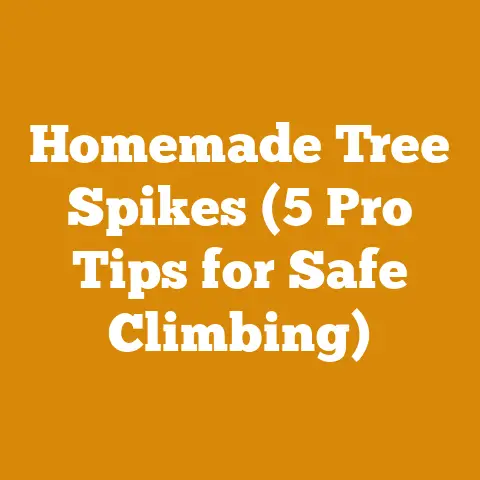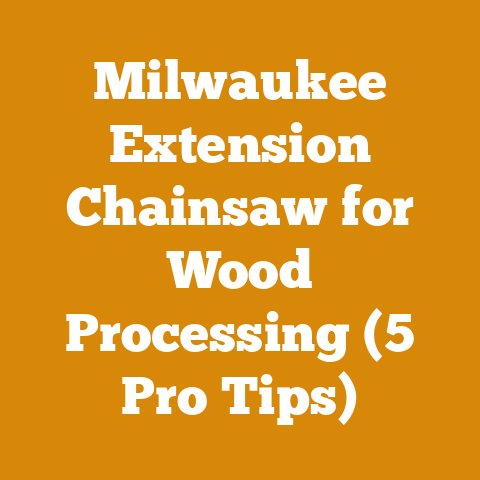EAB Treatment Cost (5 Expert Insights for Arborists)
Imagine for a moment that you’re standing in your favorite woodlot.
The sun is filtering through the canopy, dappling the forest floor.
You can hear the gentle rustle of leaves and the distant call of a woodpecker.
It’s a scene of tranquility and natural beauty.
Now, imagine that same woodlot, but this time, many of the ash trees are showing signs of decline – thinning canopies, bark fissures, and D-shaped exit holes.
The culprit?
The emerald ash borer (EAB), an invasive insect that has decimated ash populations across North America and is increasingly becoming a global concern.
As an arborist, you’re on the front lines of this battle.
You’re tasked with not only diagnosing the problem but also providing your clients with realistic and cost-effective treatment options.
And that’s where things get tricky.
The EAB treatment cost can vary wildly depending on several factors, and navigating these complexities requires a deep understanding of the science, the market, and the client’s specific needs.
Over the years, I’ve encountered numerous scenarios dealing with EAB infestations.
From small-scale residential treatments to large-scale municipal projects, I’ve seen firsthand what works and what doesn’t.
I’ve learned that a one-size-fits-all approach is not only ineffective but also potentially wasteful and damaging to the environment.
In this article, I’ll share five expert insights that I’ve gained through years of experience in the field.
These insights will help you, as an arborist, to make informed decisions about EAB treatment costs and provide your clients with the best possible solutions.
We’ll delve into the nuances of systemic insecticides, explore alternative treatment methods, and discuss the importance of preventative measures.
So, grab your chainsaw (figuratively speaking, of course!), and let’s get started.
Understanding the Emerald Ash Borer Threat
Before diving into the specifics of EAB treatment costs, it’s crucial to understand the severity of the threat.
The emerald ash borer is a small, metallic green beetle that originated in Asia.
It was first discovered in North America in 2002 and has since spread to over 35 states and several Canadian provinces.
The larvae of the EAB feed on the inner bark of ash trees, disrupting the flow of water and nutrients.
This eventually leads to the tree’s death, typically within a few years of infestation.
The impact of EAB has been devastating, with millions of ash trees already killed.
The ecological and economic consequences of EAB are significant.
Ash trees play a vital role in forest ecosystems, providing habitat for wildlife and contributing to biodiversity.
They are also valuable timber trees, used in the production of furniture, flooring, and other wood products.
The loss of ash trees can lead to changes in forest composition, increased soil erosion, and reduced property values.
The Economic Impact
The economic impact of EAB is also substantial.
According to a study published in the journal Ecological Economics, the estimated cost of EAB damage in the United States is over $10 billion.
This includes the cost of tree removal, replacement, and treatment.
Moreover, the costs extend beyond direct tree care.
Municipalities face increased expenses for managing infested trees in parks and along streets.
Homeowners experience reduced property values and the emotional distress of losing mature trees.
The lumber industry suffers from a decline in ash timber supply.
Insight 1: Systemic Insecticides – A Deep Dive into Cost and Effectiveness
Systemic insecticides are the most common treatment option for EAB.
These insecticides are injected into the tree or applied to the soil, where they are absorbed and distributed throughout the tree’s vascular system.
When EAB larvae feed on the treated tree, they ingest the insecticide and die.
Several systemic insecticides are available for EAB control, including:
- Emamectin benzoate: This is a widely used insecticide that provides long-lasting protection, typically for two to three years.
It is injected directly into the tree trunk. - Imidacloprid: This insecticide is less expensive than emamectin benzoate but provides shorter-term protection, typically for one year.
It can be applied as a soil drench or injected into the tree. - Azadirachtin: This is a naturally derived insecticide that is less toxic than synthetic options.
It provides shorter-term protection and is typically used for smaller infestations.
Factors Affecting the Cost of Systemic Insecticide Treatments
The cost of systemic insecticide treatments can vary significantly depending on several factors:
- Tree size: Larger trees require more insecticide and labor, increasing the cost.
- Insecticide type: Emamectin benzoate is generally more expensive than imidacloprid.
- Application method: Trunk injections are typically more expensive than soil drenches.
- Labor costs: Arborist labor rates vary depending on location and experience.
- Infestation level: Heavily infested trees may require more frequent treatments.
Data Point: According to a survey of arborists conducted by Purdue University, the average cost of treating an ash tree with emamectin benzoate is $10 to $15 per inch of trunk diameter.
For example, treating a 20-inch diameter ash tree would cost between $200 and $300.
My Experience: I once had a client with a beautiful, mature ash tree in their front yard.
The tree was showing early signs of EAB infestation, and they were understandably concerned.
I provided them with quotes for both emamectin benzoate and imidacloprid treatments.
While the imidacloprid treatment was less expensive upfront, I explained that it would require annual applications, whereas the emamectin benzoate treatment would provide protection for two to three years.
In the long run, the emamectin benzoate treatment was the more cost-effective option, and my client appreciated the detailed explanation and the ability to make an informed decision.
The Effectiveness of Systemic Insecticides
Systemic insecticides can be highly effective in protecting ash trees from EAB, especially when applied early in the infestation.
However, it’s important to note that these treatments are not a guaranteed cure.
- Timing is critical: Insecticides are most effective when applied before the tree is severely damaged.
- Regular treatments are necessary: Most insecticides require annual or bi-annual applications to maintain protection.
- Tree health matters: Insecticides are less effective on trees that are already stressed or unhealthy.
Unique Insight: In my experience, I’ve found that combining systemic insecticide treatments with other management practices, such as pruning and fertilization, can significantly improve the overall health and resilience of ash trees.
It’s like giving the tree a fighting chance against the EAB.
Insight 2: Beyond Systemic Insecticides – Exploring Alternative Treatment Methods
While systemic insecticides are the most common treatment option for EAB, they are not the only option.
Alternative treatment methods may be more appropriate in certain situations, such as when:
- The client is concerned about the environmental impact of insecticides.
- The tree is located near a water source or sensitive area.
- The tree is too large or too heavily infested for insecticide treatments to be effective.
Here are some alternative treatment methods to consider:
- Biological control: This involves using natural enemies of EAB to control the population.
Parasitic wasps, for example, can be released to attack EAB larvae. - Tree removal and replacement: In some cases, the most cost-effective option may be to remove infested trees and replace them with resistant species.
- Ash seed collection and preservation: Collecting and preserving ash seeds can help to maintain genetic diversity and potentially develop EAB-resistant ash trees in the future.
Biological Control: A Promising but Limited Option
Biological control is a promising alternative to insecticides, but it is not yet widely available or consistently effective.
The USDA’s Animal and Plant Health Inspection Service (APHIS) has been conducting research on several parasitic wasps that attack EAB, and some of these wasps have been released in areas with EAB infestations.
Data Point: A study published in the journal Biological Control found that the release of parasitic wasps can reduce EAB populations by up to 50% in some areas.
However, the effectiveness of biological control can vary depending on factors such as climate, habitat, and the presence of other insects.
My Experience: I’ve participated in several biological control projects, releasing parasitic wasps in infested woodlots.
While the results have been encouraging, it’s important to manage expectations.
Biological control is not a quick fix, and it may take several years to see a significant impact on EAB populations.
Tree Removal and Replacement: A Last Resort
Tree removal and replacement is often the most cost-effective option for heavily infested trees or trees that are located in areas where insecticide treatments are not feasible.
However, it’s important to consider the ecological and aesthetic impact of removing mature trees.
When replacing ash trees, it’s best to choose species that are resistant to EAB and well-suited to the local climate and soil conditions.
Some potential replacement species include:
- Oak trees: Oak trees are long-lived and provide valuable habitat for wildlife.
- Maple trees: Maple trees are fast-growing and provide shade and beauty.
- Hickory trees: Hickory trees are strong and durable and produce edible nuts.
Unique Insight: I always recommend that clients consider planting a diversity of tree species to reduce the risk of future pest or disease outbreaks.
Monocultures are much more vulnerable than diverse ecosystems.
Taking preventative measures can help to protect ash trees from infestation and reduce the need for costly treatments.
Here are some preventative measures that you can recommend to your clients:
- Maintain tree health: Healthy trees are more resistant to EAB.
Regular pruning, fertilization, and watering can help to keep ash trees healthy. - Avoid transporting firewood: EAB can be spread through the movement of infested firewood.
Encourage clients to buy firewood locally and burn it on-site. - Monitor ash trees for signs of infestation: Early detection is crucial for effective treatment.
Regularly inspect ash trees for thinning canopies, bark fissures, and D-shaped exit holes. - Consider preemptive insecticide treatments: In areas with high EAB populations, preemptive insecticide treatments may be warranted to protect valuable ash trees.
The Role of Tree Health in EAB Resistance
Healthy trees are better able to withstand EAB infestations.
Proper tree care practices can help to improve tree health and reduce the risk of infestation.
- Pruning: Remove dead, damaged, or diseased branches to improve air circulation and sunlight penetration.
- Fertilization: Apply fertilizer to provide essential nutrients and promote healthy growth.
- Watering: Water trees regularly, especially during dry periods.
- Mulching: Apply mulch around the base of the tree to conserve moisture and suppress weeds.
Data Point: A study published in the journal Forest Ecology and Management found that ash trees that were fertilized and watered regularly were more resistant to EAB than trees that were not.
My Experience: I’ve seen firsthand the difference that proper tree care can make.
Clients who invest in regular tree maintenance are less likely to experience severe EAB infestations.
It’s a long-term investment that pays off in the end.
Monitoring for Early Detection
Early detection is crucial for effective EAB treatment.
Regularly inspect ash trees for signs of infestation, such as:
- Thinning canopy: The canopy of an infested tree may appear thin or sparse.
- Bark fissures: Vertical cracks or splits may appear in the bark.
- D-shaped exit holes: Small, D-shaped holes may be visible on the bark.
- Epicormic sprouts: New shoots may emerge from the trunk or branches.
- Woodpecker activity: Woodpeckers may be attracted to infested trees to feed on EAB larvae.
Unique Insight: I recommend using a tree identification guide to help distinguish ash trees from other species.
It’s easy to misidentify trees, especially when they are not in leaf.
Insight 4: Negotiating EAB Treatment Costs with Clients
As an arborist, you play a vital role in educating your clients about EAB and helping them make informed decisions about treatment options.
It’s important to be transparent about the costs involved and to explain the benefits and risks of each treatment option.
Here are some tips for negotiating EAB treatment costs with clients:
- Provide a detailed estimate: Include a breakdown of all costs, including labor, materials, and equipment.
- Offer multiple treatment options: Present clients with a range of treatment options, from the most aggressive to the most conservative.
- Explain the long-term costs: Emphasize the long-term costs of inaction, such as the cost of tree removal and replacement.
- Be willing to negotiate: Be open to negotiating prices, especially for large-scale projects.
- Build trust: Establish a strong relationship with your clients by being honest, reliable, and knowledgeable.
Communicating the Value of EAB Treatment
It’s important to communicate the value of EAB treatment to your clients.
Help them understand the ecological, economic, and aesthetic benefits of saving their ash trees.
- Ecological benefits: Ash trees provide habitat for wildlife, contribute to biodiversity, and help to clean the air and water.
- Economic benefits: Mature trees can increase property values and reduce energy costs.
- Aesthetic benefits: Trees provide shade, beauty, and a sense of place.
Data Point: A study published in the journal Arboriculture & Urban Forestry found that mature trees can increase property values by up to 20%.
My Experience: I once had a client who was hesitant to invest in EAB treatment.
They were concerned about the cost and weren’t sure if it was worth it.
I took the time to explain the benefits of saving their ash trees, not only for their property value but also for the environment and the community.
In the end, they decided to proceed with the treatment, and they were thrilled with the results.
Addressing Client Concerns
Clients may have various concerns about EAB treatment, such as the cost, the effectiveness, and the environmental impact.
Be prepared to address these concerns with accurate information and empathy.
- Cost: Explain the long-term costs of inaction and offer flexible payment options.
- Effectiveness: Be realistic about the limitations of EAB treatments and emphasize the importance of early detection and regular treatments.
- Environmental impact: Choose environmentally friendly insecticides and consider alternative treatment methods.
Unique Insight: I always encourage clients to get a second opinion.
It’s important for them to feel confident in their decision.
Insight 5: Staying Up-to-Date on EAB Research and Best Practices
The field of EAB research and management is constantly evolving.
It’s essential to stay up-to-date on the latest findings and best practices to provide your clients with the most effective and informed advice.
Here are some resources for staying up-to-date on EAB:
- University extension services: Many universities offer EAB resources and training programs.
- Professional organizations: Organizations such as the International Society of Arboriculture (ISA) and the Tree Care Industry Association (TCIA) provide EAB information and continuing education opportunities.
- Government agencies: The USDA’s Animal and Plant Health Inspection Service (APHIS) and the Environmental Protection Agency (EPA) provide EAB regulations and guidelines.
- Scientific journals: Journals such as Forest Ecology and Management and Biological Control publish research on EAB and other forest pests.
Attending Industry Conferences and Workshops
Attending industry conferences and workshops is a great way to learn about the latest EAB research and best practices and to network with other arborists.
My Experience: I regularly attend industry conferences and workshops to stay up-to-date on the latest EAB developments.
I’ve learned a great deal from these events, and I’ve also made valuable connections with other professionals in the field.
Conducting Your Own Research
In addition to relying on external resources, consider conducting your own research to evaluate the effectiveness of different EAB treatment methods in your area.
- Monitor treated trees: Track the health and survival of treated trees over time.
- Collect data: Gather data on EAB populations, tree growth rates, and treatment costs.
- Analyze the results: Analyze the data to determine which treatment methods are most effective and cost-efficient.
Unique Insight: I’ve found that conducting my own research has helped me to refine my EAB treatment strategies and provide my clients with more effective and tailored solutions.
Conclusion: A Proactive Approach to EAB Management
The emerald ash borer is a serious threat to ash trees, but it is not insurmountable.
By understanding the complexities of EAB treatment costs and implementing a proactive management approach, you can help your clients protect their valuable ash trees and preserve the health and beauty of our forests.
Remember these five key insights:
- Systemic insecticides are a common treatment option, but their cost and effectiveness vary depending on several factors.
- Alternative treatment methods, such as biological control and tree removal and replacement, may be more appropriate in certain situations.
- Preventative measures, such as maintaining tree health and monitoring for early detection, are crucial for reducing the risk of EAB infestation.
- Negotiate EAB treatment costs with clients by providing detailed estimates, offering multiple treatment options, and communicating the value of EAB treatment.
- Stay up-to-date on EAB research and best practices by attending industry conferences, reading scientific journals, and conducting your own research.
As arborists, we have a responsibility to protect our trees and forests from the threat of EAB.
By working together, we can make a difference and ensure that future generations can enjoy the beauty and benefits of ash trees.
Now, go out there and put these insights into practice!
Your expertise and dedication will make a real difference in the fight against EAB.






